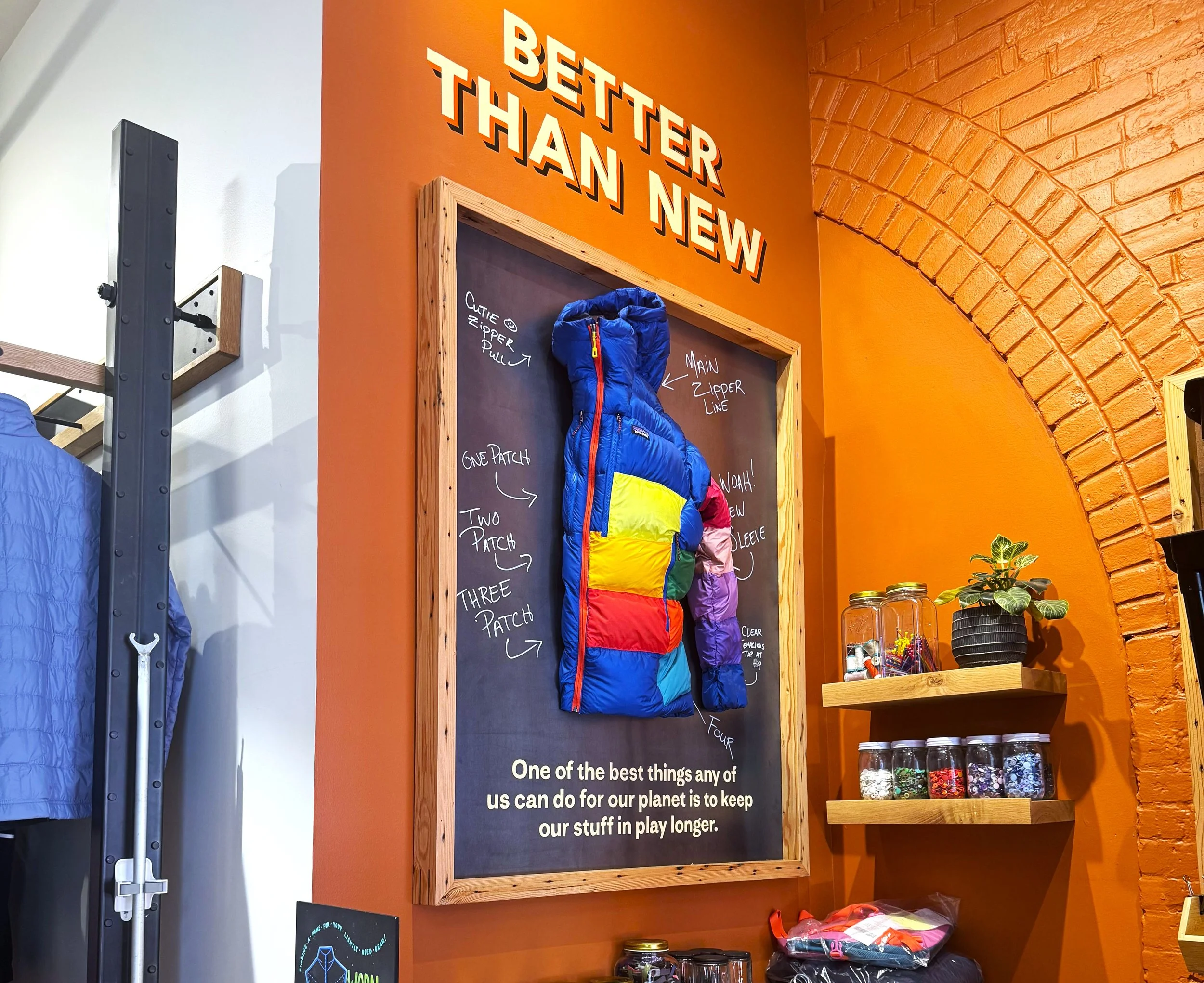The Rise of Repairs and Customization in Outdoor & Performance Retailers
Levis SoHo (August 2025) includes a tailor shop and the ability to repair and add personality to your denim.
In an era of ultra-fast fashion, where trends are measured in days and garments are designed for obsolescence, outdoor and performance brands are leading the rebellion.
Instead of encouraging endless consumption, brands like Puma, Arc’teryx, and Fjällräven are proving that longevity, personalization, and repairability can be just as powerful and far more sustainable. Their approach flips the script; rather than chasing the next trend, they’re deepening customers’ connection to gear and clothing.
This growing “anti-fast fashion” movement is about more than extending a product’s lifespan. It’s about building trust, fostering brand loyalty, and creating authentic experiences where customers participate in the lifespan of their clothing and gear through in-store customizations and on-site repairs.
Why are Outdoor & Performance Brands leading the Repairs and Customization Movement?
Climate Change Is Reshaping How Their Customers Play
Although there are other notable brands making strides in sustainability, outdoor and performance brands are leading the way because their activities are deeply tied to nature. From hikers to marathoners, their customers live to be outdoors. This direct connection to nature means shorter snow seasons, smoky skies, and unpredictable weather aren’t abstract concerns; they’re changing how these customers play, train, and adventure. They want to see the brands they support making a noticeable difference in how their operations affect the environment. Incorporating sustainable values inside their profit centers shows these companies are aligning their business practices with the values of their customers and the environments they depend on.
The North Face Flatiron (August 2025) includes storytelling elements that acknowledge climate concerns.
Durability and Longevity Are Already Core to Their Products
Outdoor and performance brands have always existed at the intersection of innovation and functionality. Unlike traditional fashion, their products aren’t made to be worn once; they’re designed for intense use in rugged conditions season after season. Many of these products are built as investment pieces with quality and longevity at the forefront. This mindset positions outdoor and performance brands at the forefront of the anti–fast fashion movement, where value is measured not by the lowest price, but by how well products perform and how long they can be used and loved. Their commitment to durable design naturally aligns with the principles of sustainability and continues to earn the trust of customers who prioritize purpose over trends.
Arc’teryx Seattle (April 2024) has a small service center dedicated to the longevity of their gear and promising customers that they will help solve any issues that may come from using their gear the way it was intended.
Repairs and Customization Turn Sustainability Initiatives Visible
Sustainability reports, brand commitments, and transparency are now standard and expected in the outdoor space and are becoming more popular in the performance space. Although these are still key in being authentic in today’s era of greenwashing, customers are far more influenced by what they can experience. A repair counter, a customization bar, or even a small in-store workstation builds trust that a brand truly stands behind the longevity of its products. These physical touchpoints invite customers to participate in sustainability rather than simply read about it. For many shoppers, seeing a jacket being repaired or someone personalizing their gear is a far more powerful message than a 50-page ESG report.
Cotopaxi Bridgeport Village (October 2024) highlights their gear made of repurposed materials, adding character and a unique one-of-a-kind product.
The Benefits of Repair and Customization for Retailers
Deepened Brand Loyalty
When customers repair or customize their products, they’re strengthening their emotional connection to the brand behind it. Each repair tells a personal story as well as proves that the brand stands behind its promise of creating quality products, and each customization transforms a simple purchase into an emotional and lasting connection. This process turns ownership into partnership, where the brand becomes part of the customer’s lifestyle rather than just a one-time transaction. These experiences build genuine brand loyalty that marketing alone can’t achieve. A jacket patched in-store or a pair of boots customized to fit perfectly becomes proof of shared values and craftsmanship as well as a tangible reminder of why the customer chose your brand in the first place.
Puma 5th Ave (August 2025) has a dedicated customization desk that allows customers to make their purchases uniquely theirs.
Increased In-Store Engagement & Reasons to Visit
Repair and customization programs drive traffic by giving customers meaningful reasons to step inside. Customization stations encourage shoppers to purchase in-store, where they can see, feel, and personalize the product on the spot. Meanwhile, repair stations keep customers coming back even when they’re not in the market for something new and offer services, community, and care that strengthen long-term relationships.
Yeti, Washington Square, Portland (October 2024) The self-service customization shop gives customers a way to make their new purchase uniquely theirs.
Differentiates the Brand from Competitors
Many retailers hesitate to dedicate floor space to repairs or customization, viewing it as a loss in potential product displays and profit. By visibly demonstrating their commitment to sustainability and customer experience, these spaces communicate that your brand is invested in more than just the point of sale.
In a competitive retail landscape, this visible commitment sets your store apart. It signals that you value quality, longevity, and community, all attributes that today’s conscious consumers are actively seeking.
Lululemon, Midtown (August 2025) has a colorful repair shop that shows the customer their dedication to the longevity of their products.
How to Integrate Repair and Customization Into Your Store Design
Now that you understand why repair and customization matter, let’s explore how to bring them to life in your retail environment. When done well, these areas become memorable touchpoints that build trust and deepen engagement.
Create a Dedicated Space
Repair and customization work best when customers can clearly see and experience them. A designated space, no matter how small, signals that your brand stands behind the longevity of its products. Even with limited square footage, modular counters or seasonal pop-ups can make a big impact.
The design of these stations should reflect your brand’s aesthetics and values. Use materials and fixtures that complement the rest of your space so the station feels fully integrated, not like a back-of-house workshop brought forward. Warm lighting, visible tools, and intentional layout choices can make the process feel like an extension of your craftsmanship rather than a service tucked away.
Levis SoHo (August 2025) has a dedicated desk and menu showing that their tailor shop is just as important as their products.
Fill a Local Need
Repair and customization programs are most effective when they’re rooted in the needs of the local community. Whether it’s offering quick fixes for gear in an active outdoor town or specific tailoring services, aligning your offerings with local habits creates real value. This shows that your brand understands how people live, play, and move in their environment, truly transforming your store from a place to shop into a trusted resource within the community.
Communicate the “Why” Behind It
Your customers may not immediately understand the value of repair or customization; that’s where storytelling comes in. Clear signage, looping videos, and storytelling walls help communicate why these programs exist and what they represent.
Whether you’re highlighting your commitment to sustainability, product longevity, or craftsmanship, these design elements turn the space into an educational experience. They invite customers to connect with your mission while watching your brand values come to life in real time. When people understand the purpose behind what you do, they’re far more likely to participate and to share that story with others.
Patagonia SoHo (August 2025) shares the reason why they created their repair shop.
Final Thoughts on the Rise of Repairs and Customization in Retail
Repairs and customization are more than just add-on services; they’re a statement about what your brand stands for. In an era dominated by ultra-fast fashion and disposable trends, outdoor and performance retailers are leading a quiet revolution centered on longevity, craftsmanship, and connection. These experiences remind customers that quality gear is worth investing in, caring for, and keeping for the long haul. By integrating repair and customization into your retail strategy, you’re not only reducing waste, you’re deepening brand loyalty, building community, and reinforcing the values that define your brand.
Now that you understand why outdoor and performance retailers are incorporating repair and customization stations, it’s time to integrate them into your retail strategy. With over 15 years of architecture, in-house brand, and design agency experience for influential brands including HOKA, Arc’teryx, Nike, Adidas, and Garmin, Feels on Brand is the go-to retail experience design studio for creating unforgettable retail spaces. Together, we'll help navigate designing and implementing your next retail brand experience.
Learn more about how our team will bring your vision to life through our key services and how to get started reserving your project timeline on our planning page.










